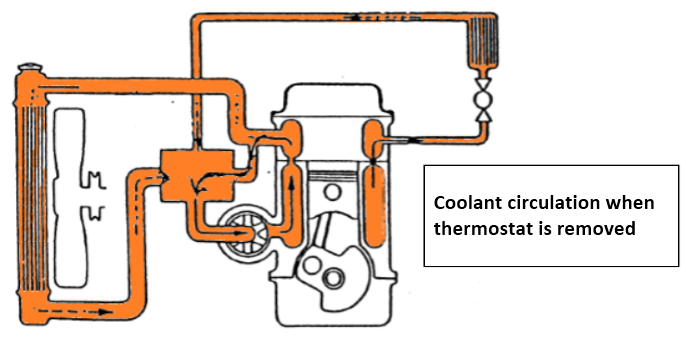The effects if you remove thermostat from car
Many people often recommend removing the engine thermostat from the cooling system when an engine overheats problems occurs, especially if it is not in a damaged state during the inspection. The engine thermostat plays an important role in regulating the radiator coolant's circulation and temperature required by the engine.
Removing the engine thermostat from the cooling system can cause the engine's cooling system to work abnormally. The engine thermostat regulates the radiator coolant's time flow based on the radiator coolant temperature.
When the coolant radiator cools, the thermostat valve closes the coolant path leading to the radiator. Then the coolant only circulates in the engine through the by-pass line, directly connected to the water pump. Please pay attention to the cooling water circulation when the temperature is still cool, as shown below.
The thermostat valve that closes the path to the radiator will accelerate the heat process of the engine's working temperature so that the engine is faster and ready for use. In effect, less fuel is used to heat the engine.
The thermostat valve leading to the radiator opens and closes the by-pass channel when the engine temperature is hot. This condition will cause cold coolant from the radiator to flow into the engine and then push out the engine's hot coolant to enter the radiator. Look at the image below.
Radiator functions to cool down the coolant's temperature that just entered earlier so that the radiator's hot coolant will be cooler. Read: How the radiator works when cooling the temperature of the cooling water.
At the same time, the cold coolant that previously flowed into the thermostat will gradually close the thermostat valve. When coolant is exchanged from the radiator to the engine and vice versa, it can maintain the engine working temperature.
So what happens when the thermostat is removed and not used in the engine cooling system? Look at the image below.
When the thermostat is not installed (removed) from the engine cooling system, the coolant will flow and circulate in the engine without the cooling down process inside the radiator. It will have an impact on overall engine performance. The following is the effect that occurs due to removing the thermostat from the car.
1. Engine shakes
The first effect that occurs when the engine thermostat is removed from the cooling system is that the engine shakes due to the engine's normal working temperature being difficult to achieve. This condition will be experienced when the coolant temperature is still cold.
When the engine temperature is cold, the engine thermostat valve should shut off the coolant flow to the radiator. If the engine thermostat is removed, the coolant will continue to flow (due to being pumped by the water pump), making the engine working temperature difficult to reach.
This difficulty to reach the engine working temperature will result in an imbalance in the fuel supply that enters the engine cylinder. In effect, there will be a stronger vibration in the engine and cause the engine to shake.
2. Engine knocking
The next effect that will occur when the engine thermostat is removed from the cooling system is the appearance of knocking on the engine. The appearance of knocking often occurs when the engine temperature has exceeded normal limits but has not entered the overheating phase, which can cause the engine to stall.
Knocking will occur because the compressed fuel inside the engine has exploded before igniting by the spark plug. This event results from the engine temperature, where the heat has exceeded the engine's normal working temperature limit.
Also read:- How car cooling system works?
- Why is my car overheating? Here they are the causes
- Components of car engine cooling system
3. Overheat in the traffic jam
A removed engine thermostat from the cooling system will cause the car engine to overheat more easily. The engine will be difficult to cool the engine's coolant temperature when the car is stuck in a traffic jam,.
That happens because the coolant continues to flow and does not stop at the radiator. Coupled with a traffic jam situation that makes the car less cold air flowing through the radiator. The effect is the easier the engine knocking, overheating, and then stall due to overheating.
4. Fuel consumption becomes more wasteful
The last effect that felt due to the engine thermostat not being installed in the engine cooling system is fuel consumption which becomes more wasteful. Yes, this condition results from the failure of the cooling system to maintain optimal engine working temperature.
For example, when the engine is still cold, the engine requires more fuel to reach the ideal working temperature. It makes fuel become wasteful. Likewise, when the engine is hot and knocking occurs. When the engine knocking happens, it makes the EFI system fail and enter failsafe mode. As a result, the system is set to inject fuel regularly at some engine rpm conditions to increase fuel consumption.
Yes, the thermostat removed from the engine cooling system will cause at least four effects, as described above. So, still, dare to remove the thermostat from the engine cooling system?



